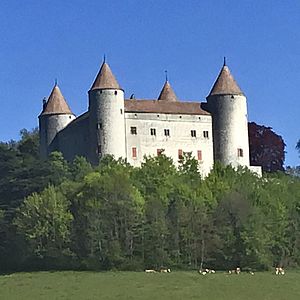Pierre de Champvent facts for kids
Pierre de Champvent was a nobleman from a region called Savoy (which is now part of France and Switzerland). He lived a long time ago, in the 1200s and early 1300s. Pierre moved to England and became an important person in the royal court, working for the King. He was a soldier and a trusted helper to the King.
Contents
Early Life and Moving to England
Pierre de Champvent came from a noble family in a place called Vaud, which was close to the county of Savoy in the 1200s. His father was Henri, the Lord of Champvent. Pierre had two brothers, Guillaume and Othon, who both became important church leaders (bishops) later on.
Pierre, like his brothers, likely came to England with his uncle, Pierre de Grandson, and his cousin, Otto de Grandson. They were part of the group that traveled with Peter II, Count of Savoy. Peter II was an uncle to Queen Eleanor of Provence, who was married to King Henry III of England. This connection helped Pierre get started in England.
Working for King Henry III
Pierre de Champvent is first mentioned in England in 1252. He worked as a steward (a kind of manager) at the court of King Henry III of England. Before 1259, he was made a knight.
His importance grew, and in 1262, he was listed as a witness for an important document about the Queen's money. As a knight in the King's household, he helped in battles during a time of civil war in England called the Second Barons' War. He helped capture the town of Northampton in 1264. He also took part in the long fight to take over Kenilworth Castle in 1266. He even brought extra war machines, like large crossbows, to help with the siege.
In 1269, Pierre became the Sheriff of Gloucestershire and the constable (in charge) of Gloucester Castle. The King gave him land and other special rights as a reward for his loyalty. Back in Vaud, after his father passed away, Pierre inherited the Champvent lordship. He had other people manage his lands there while he was busy in England. It's believed that during his time, Champvent Castle was built. It was designed like another famous castle, Yverdon-les-Bains Castle, which was built by a well-known builder named James of Saint George.
Serving King Edward I
After King Henry III died, his son, Edward I of England, became king. At first, Pierre de Champvent seemed less important to the new King. However, Pierre soon gained King Edward I's trust. He helped in the conquest of Wales, where England took control of Wales.
By the late 1280s, Pierre was the steward of the Household again, a very important role. He was invited to special meetings of Parliament, where he helped the King by taking requests from people. In 1292, he became the Chamberlain of the Household, an even higher position.
During a Welsh uprising in 1294, Pierre was with the King when they were briefly trapped in Conwy Castle by the rebels. He also joined the King's army in Flanders (now Belgium) in 1297 during a war with France. The next year, he fought in the Battle of Falkirk against Scotland.
King Edward I was not known for giving out many gifts. So, Pierre's rewards from Edward I were mostly money and a few other small gifts. But Pierre was smart and used his connections with other English nobles to get more land. He ended up owning properties in different parts of England, like Sussex and Cambridgeshire.
Family Life
Pierre de Champvent was married to a woman named Agnes, who was also likely from Savoy. He probably passed away in England between 1302 and 1303. His son, John, inherited his lands. However, John did not become as important at the English court as his father, Pierre.



